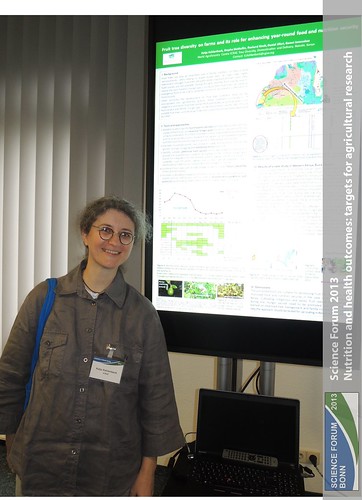Kenya
Agroforestry and fruit diversity enhance food and nutrition security
Tue, 09/24/2013 - 09:38 — Louisa Wong
During the first day of the Science Forum, we have 2 sessions of “knowledge share fair” for scientists to present and discuss their studies in digital format and a cozy setting with morning coffee and hot buns served. When I came into the room, there were already a few people crowded in front of a “poster”. Katja Kehlenbeck works for ICRAF- Would Agroforestry Centre in their Nairobi office in Kenya, and she was telling us how their newly developed model “Fruit tree portfolios” can identify local specific fruit tree sets, which help the Kenyan farmers to reintroduce fruit trees into their farms according to seedling availability and seasons.
 Katja was presenting in the knowledge share fair during SF 2013
Katja was presenting in the knowledge share fair during SF 2013
 Katja was presenting in the knowledge share fair during SF 2013
Katja was presenting in the knowledge share fair during SF 2013
Oral presentation II | Forest management (part 1)
Thu, 09/16/2010 - 12:18 — De-Registered User
After got introduced to the palm oil production potential in Tanzania by Anna Segerstedt from the Institut for Environetal Economics and World Trade at the Leibnitz University Hannover with respect to sustainability standards the point was clear: there is no chance under the assumed conditions to produce palm oil for the export market as well as for label production due to export barriers and costs linked to certification respectively. Ms Segerstedt found however, that according to her results the palm oil production for the local market is competitive.
Zora Lea Urech from the Department of Environmental Sciences at ETH Zurich outlined in her interesting presentation possible drivers leading to further deforestation in the eastern part of Madagascar taking into consideration the main components of the livelihood strategies of small farm-households. The complex land tenure system, next to other factors, hinders a sustainable use of the forest ecosystems and need to be further investigated.




